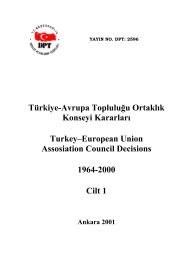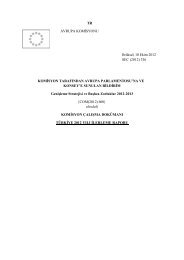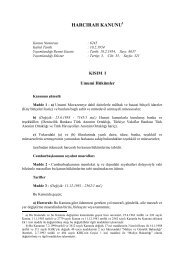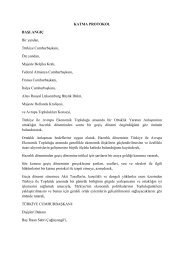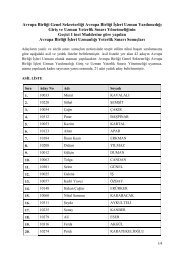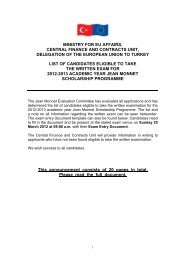2010 ilerleme raporu - Avrupa BirliÄi BakanlıÄı
2010 ilerleme raporu - Avrupa BirliÄi BakanlıÄı
2010 ilerleme raporu - Avrupa BirliÄi BakanlıÄı
You also want an ePaper? Increase the reach of your titles
YUMPU automatically turns print PDFs into web optimized ePapers that Google loves.
Annual inflation was 6.3% in 2009. A combination of several unfavourable developments,<br />
such as price increases for unprocessed food and oil, base effects and administered price rises,<br />
has led to a significant increase in inflation since the last quarter of 2009. These factors<br />
pushed headline inflation significantly above the central bank target, leading to an adverse<br />
impact on inflation expectations. Between November 2009 and April <strong>2010</strong>, inflation rose<br />
from 5.1% to 10.2% before falling to 8.3% in August, reflecting large volatility in food prices.<br />
The central bank expects inflation to fall towards the end of <strong>2010</strong>, although it is unlikely to<br />
reach the central bank end-year target of 6.5%. Core inflation went up from about 3% in mid-<br />
2009 to 4% by August-<strong>2010</strong>. Turkey’s real policy rate is now low given the robust economic<br />
recovery. Cuts in the policy rate were transmitted to market rates, but at speeds and passthrough<br />
rates that varied across instruments. Rates on corporate lending declined the most, by<br />
more than 15 percentage points. Recovering domestic demand and easing lending standards in<br />
the second half of 2009 helped revive credit supply which accelerated further to an annualized<br />
rate of around 30% in the first half of <strong>2010</strong>.The Turkish central bank is looking ahead to a<br />
period of strong growth and has announced plans to roll back the extraordinary measures put<br />
in place during the economic crisis in 2009 and to inject less liquidity into the market and<br />
currency reserves requirements have been increased. The operational structure of the central<br />
bank's liquidity management has been changed in order to ensure a better allocation of<br />
liquidity within the banking system and to reduce the dependence of banks on the central<br />
bank's lending facilities. Taking into account its reading of the – not yet closed – output gap<br />
(according to estimates by the central bank), the Monetary Policy Committee has indicated<br />
that the monetary tightening/exit strategy should be prudent and slow. Overall, price stability<br />
worsened, chiefly because of pressures stemming from energy and food inputs and buoyant<br />
economic activity, triggering a tighter monetary stance.<br />
Turkey’s fiscal consolidation over the past decade was very significant as, in the wake of the<br />
2001 financial crisis, the government managed to cut the public debt to GDP ratio from a high<br />
of over 70% in 2001 to less than 40% by mid- 2008. Structural loosening as well as cyclical<br />
factors weakened the fiscal balance from mid-2008 to mid-2009. The deterioration in public<br />
finances accelerated as fiscal measures to stimulate economic growth, equivalent to about 5%<br />
of GDP over the period 2009-2011, were taken to minimise some of the adverse effects of the<br />
crisis. They appear to have successfully propped up private consumption and are being phased<br />
out gradually. But they also caused the budget deficit to soar from 2.2% of GDP in 2008 to<br />
about 5.7% in 2009. So far, the budget performance has improved in <strong>2010</strong>. Budget realisation<br />
in the first six months of <strong>2010</strong> was much better than anticipated, as strong consumption is<br />
leading to higher tax revenue performance (up 20% year-on-year). Tax increases also<br />
contributed (VAT and special consumption taxes on, amongst others, cars and white goods<br />
had previously been lowered to prop up consumption). Subsequently, in the first half of the<br />
year, the budget deficit declined significantly to only about half last year’s. The exit strategy<br />
was less visible on the spending side, as real expenditure remained at the same level as in<br />
2009. There are signs that pressures in some expenditure categories are building up (mainly<br />
personnel expenditure and capital spending). The public debt stock rose by around 6% yearon-year<br />
to less than 45% of GDP in mid-<strong>2010</strong>. According to the government, public debt<br />
should drop to the low 40s by the end of <strong>2010</strong>, and subsequently continue to fall slowly. With<br />
an election scheduled in 2011, however, the fiscal picture could change. Overall, although the<br />
anti-crisis measures have cushioned the economic downturn, they must be exited in a timely<br />
fashion and targeted in order to lay the foundations for strong, sustained and balanced growth.<br />
The Public Financial Management Law was supposed to be implemented between 2007 and<br />
<strong>2010</strong> and to make Turkey’s public finance administration broadly consistent with EU<br />
standards on internal controls. However, three years after the adoption of the law, the<br />
EN 40 EN




